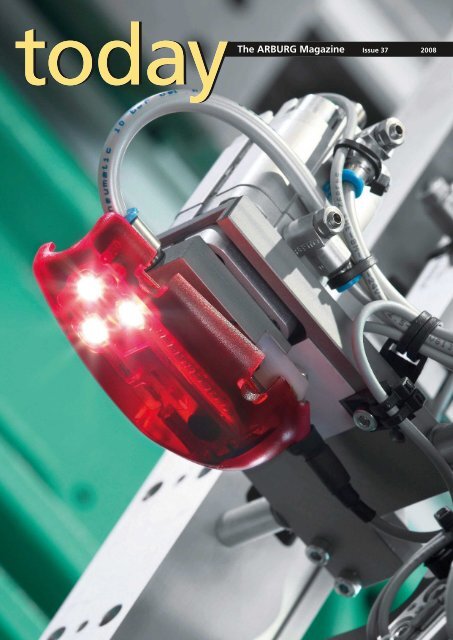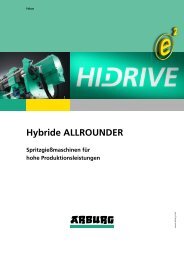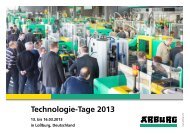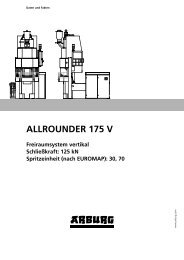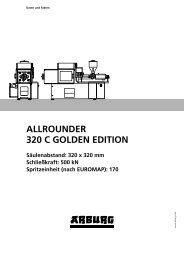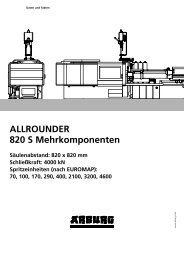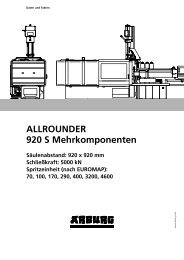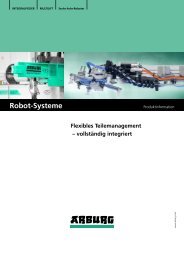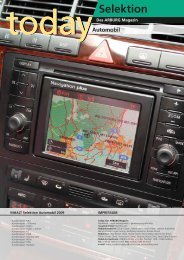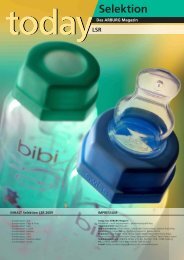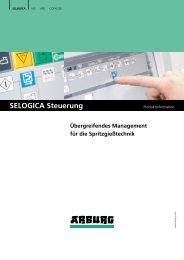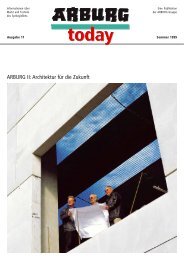GB - Arburg
GB - Arburg
GB - Arburg
Create successful ePaper yourself
Turn your PDF publications into a flip-book with our unique Google optimized e-Paper software.
The ARBURG Magazine Issue 37 2008
CONTENTS<br />
4<br />
6<br />
7<br />
8<br />
10<br />
12<br />
13<br />
14<br />
15<br />
16<br />
18<br />
20<br />
22<br />
MASTHEAD<br />
Customer report<br />
ENGIMICS: Turbine cores, Swiss Made<br />
Product<br />
MULTILIFT V SELECT: Learning step-by-step<br />
Product<br />
Talking about host computers<br />
Customer report<br />
Rudolf Michael: Coil shells of all kinds<br />
Service<br />
Oil management counts<br />
Service<br />
Assuring quality<br />
Our company<br />
Double celebration in Denmark<br />
Our company<br />
Two new ATCs for USA<br />
Our company<br />
ARBURG now in Mexico<br />
Customer report<br />
XRAY: Small-scale racers<br />
Our company<br />
Training: Investment in the future<br />
Project<br />
Kongsberg Automotive: Automated automotive<br />
Tech talk<br />
Energy-efficient design<br />
today, the ARBURG magazine, issue 37/2008<br />
Reprints - including excerpts - only by express permission<br />
Responsible: Matthias Uhl<br />
Editorial advisory board: Oliver Giesen, Juliane Hehl, Martin Hoyer, Herbert Kraibühler,<br />
Bernd Schmid, Jürgen Schray, Wolfgang Umbrecht, Renate Würth<br />
Editorial team: Uwe Becker (text), Markus Mertmann (photos), Oliver Schäfer (text),<br />
Ralph Schreiber (text), Vesna Serti� (photos), Susanne Wurst (text), Peter Zipfel (layout)<br />
Editorial address: ARBURG GmbH + Co KG, Postfach 1109, 72286 Lossburg, Germany<br />
Tel.: +49 (0) 7446 33-3149 Fax: +49 (0) 7446 33-3413<br />
e-mail: today_kundenmagazin@arburg.com, www.arburg.com<br />
2 today 37/2008<br />
Jointly with Oechsler AG, ARBURG<br />
demonstrated a future trend with<br />
the manufacture of a fully-functional<br />
LED light strip in a single production<br />
step at the K 2007.
First things first: we are very<br />
happy with how the year<br />
2007 has gone. ARBURG<br />
was able to continue proving<br />
itself as a reliable partner in<br />
the industry, and even considerably expand its volume<br />
of business.<br />
Dear Readers,<br />
Of course, our successful presence at the K 2007, the<br />
leading international trade fair in Düsseldorf, was a major<br />
highlight. One of our most important exhibits was the<br />
fully automated production of an LED light strip, which<br />
you can see on the title page. This process, which greatly<br />
impressed global injection moulding circles, was made<br />
possible by the use of a special, conductive plastic and the<br />
encapsulation of the highly sensitive LED component.<br />
With this application, achieved in collaboration with<br />
Oechsler AG, ARBURG was again able to demonstrate<br />
its power of innovation and present itself as a strong<br />
partner for the future: a partner who, over decades, has<br />
displayed stability, continuity and solid growth. You can<br />
rely on ARBURG - all around the world.<br />
Consequently, in 2007 we also intensified the internation-<br />
alisation of our company. Our aim is to further improve<br />
customer proximity and the high quality of our customer<br />
support around the world, and to bring our service offer<br />
up to the level of Lossburg. This process is assisted by the<br />
increased exchange of information between employees<br />
and the transfer of know-how between the head office<br />
and the subsidiaries. You will find key examples of invest-<br />
ments in the global sales and service network in the USA,<br />
Mexico and Denmark in this issue of “today” .<br />
We hope you enjoy reading this new issue.<br />
today 37/2008<br />
3<br />
Helmut Heinson<br />
Managing Director Sales<br />
EDITORIAL
Photos: ENGIMICS SA<br />
When Swiss Made and Made<br />
in Germany work jointly on<br />
the production of moulded<br />
parts, the only possible result is extremely<br />
high precision and high quality<br />
technical parts. The Swiss company<br />
ENGIMICS SA makes use of a specially<br />
configured vertical ALLROUNDER<br />
630 C to manufacture ceramic cores<br />
in a powder injection moulding (PIM)<br />
process. These, in turn are used in the<br />
manufacture of gas turbine blades.<br />
ENGIMICS SA can best be described<br />
as a start-up company. Its foundation, in<br />
Novazzano/Ticino, dates back only to July<br />
2005. Starting out with four employees,<br />
the company now has ten, who manage<br />
the high-tech manufacturing processes<br />
in a production area with a floorspace of<br />
1,400 square metres. The company is still<br />
growing, and market developments are<br />
very positive.<br />
ENGIMICS produces around 12,000 of<br />
Turbine cores,<br />
the highly complex ceramic cores annually,<br />
achieving a sales volume of some 1.3 million<br />
euros. In this context, a look at the<br />
market that the company serves proves<br />
revealing. ENGIMICS customers come<br />
from the manufacturing industry, who in<br />
turn supply OEMs as well as the operators<br />
of gas turbine power stations. Both<br />
gas turbines for power generation and for<br />
aircraft engines are high-tech power units,<br />
which are produced almost exclusively in<br />
industrial countries with a high level of<br />
technical expertise.<br />
The main component of these turbines<br />
is the turbine blades, which are subjected<br />
to extremely high temperatures. For this<br />
reason, the blades must be intensively<br />
cooled. An important process step during<br />
their production is the inclusion<br />
of cooling channels inside the<br />
blades. This is where the ceramic<br />
cores, which are manufactured<br />
by ENGIMICS from<br />
silicon oxide ceramics in the<br />
4 today 37/2008<br />
Photo: ©Pitopia / Steffen Loshe -Koch<br />
PIM or CIM process, come into play. The<br />
main selling market for ENGIMICS products<br />
is currently the Swiss precision casting<br />
industry, whose customers, the turbine<br />
manufacturers, are principally based<br />
in Europe and the USA.<br />
The first contact between ENGIMICS<br />
and ARBURG dates back to the company’s<br />
founding year, 2005. The ALLROUNDER<br />
630 C with a clamping force of 2,500 kN<br />
and size 1300 injection unit employed to<br />
produce the ceramic cores is equipped<br />
with some special features that have been<br />
adapted for use in the ENGIMICS production<br />
environment. The machine’s clamping<br />
unit opens vertically upwards so that the<br />
green components lie freely accessible on<br />
the lower part of the mould, from where
Swiss Made<br />
they can easily be picked up. The injection<br />
unit is designed to be highly wear resistant,<br />
the cylinder is made from high-chromium,<br />
powder-metallurgically produced<br />
steel (BMA), the screw consists entirely of<br />
powder-metallurgically produced, hardened<br />
steel.<br />
Ceramic cores with a length of up to 700<br />
millimetres and a weight of 2,000 grams<br />
can be produced using this ALLROUNDER<br />
configuration, which runs in single-shift<br />
operation at ENGIMICS. A typical product<br />
is cores with a length of 400 millimetres<br />
and thicknesses between 0.6 and 20 millimetres<br />
for use in gas turbines made by<br />
General Electric, for example. Powers of<br />
up to 200 megawatts can be generated<br />
using these turbines.<br />
Three connections for hydraulic mould<br />
slides and six temperature control device<br />
interfaces are necessary for the single-cavity<br />
mould and reliable demoulding of the<br />
complex ceramic cores. Automatic ejectors<br />
lift the filigree, not yet fully hardened<br />
core out of the concave mould side. The<br />
green components are then debinded and<br />
sintered, after which they achieve their<br />
final size and strength.<br />
According to ENGIMICS, co-operation<br />
with ARBURG runs very smoothly because<br />
as a machine manufacturer, ARBURG reacts<br />
very flexibly to the company’s requirements,<br />
“We are thoroughly satisfied with<br />
the ALLROUNDER machine technology.<br />
Maintenance is carried out in accordance<br />
with an inspection contract. With this<br />
sophisticated injection moulding technology,<br />
we can ensure optimum dimensional<br />
stability of our components. In future, we<br />
would also like to set up programme and<br />
data management via PC. Consequently,<br />
there is plenty of scope for further cooperation<br />
between “Swiss Made” and<br />
“Made in Germany”.<br />
today 37/2008<br />
5<br />
INFOBOX<br />
CUSTOMER REPORT<br />
The ceramic cores (photo, bottom left) are manu-<br />
factured on a specially configured ALLROUNDER<br />
630 C (photo, left). The machine’s clamping unit<br />
opens vertically upwards so that the finished green<br />
components lie freely accessible on the lower part<br />
of the mould (photo, right).<br />
Founded: July 2005<br />
Location: Ticino, Switzerland<br />
Production area: 1,400 square metres<br />
Employees: Ten<br />
Products: Ceramic cores for the production<br />
of turbine blades using<br />
the PIM injection moulding process<br />
Contact: ENGIMICS SA,<br />
Via Roncaglia 20,<br />
Casella postale 104,<br />
6883 Novazzano/TI, Switzerland
PRODUCT<br />
Learning step-by-step<br />
Step-by-step, intelligent robotic<br />
systems can “learn” the positions<br />
they are to move to in<br />
order to pick up and set down parts<br />
with the highest precision. A teachin<br />
function of this type is now also<br />
available for ARBURG’s MULTILIFT V<br />
SELECT robotic system via the<br />
SELOGICA ‘direct’ control system.<br />
The MULTILIFT V SELECT, which was introduced<br />
onto the market at the K 2007, is<br />
a newly configured servo-electric robotic<br />
system that is competitively priced thanks<br />
to a set of pre-defined features. A suitable<br />
MULTILIFT V SELECT is available for each<br />
machine size of the ALLROUNDER A and<br />
S (270 upwards). The introduction of this<br />
basic robotic system responded to customers’<br />
wishes for a simple programming<br />
solution - ideally without the need for specialised<br />
programming knowledge. Consequently,<br />
the new teach-in function is now<br />
available on the MULTILIFT V SELECT.<br />
But how exactly does this enable the<br />
robotic system to become more “intelligent”,<br />
when in many cases the operator<br />
knows the movement sequence of the robotic<br />
system - for part removal, for example<br />
- but is unfamiliar with the programming<br />
options.<br />
In the so-called “Teach mode”, all the<br />
positions of the robotic system are moved<br />
to manually in succession. The various<br />
positions are simply confirmed via the<br />
“Teach” button. All the necessary parameter<br />
entries are then performed automatically<br />
in the control system. Simultaneously,<br />
SELOGICA ‘direct’ independently generates<br />
the robotic sequence and integrates<br />
it into the machine cycle. The last-entered<br />
position can be cancelled via an “undo”<br />
function, in order to quickly reverse incorrect<br />
programming.<br />
The new teach-in function makes the<br />
programming of robotic systems easier<br />
thanks to its intuitive operating options.<br />
Installation technicians and machine operators<br />
can easily create robotic<br />
sequences and position them<br />
in the machine cycle. The robotic<br />
system is rendered<br />
highly flexible owing to<br />
this new, free form of<br />
programm<br />
i n g .<br />
All the<br />
i n d i -<br />
vidual<br />
removal sequences<br />
can be<br />
implemented easily and reliably.<br />
The fine tuning of all the robotic<br />
system movements can be performed<br />
via the stored parameter<br />
screens in the sequence<br />
editor of the SELOGICA<br />
‘direct’ control system. In<br />
6 today 37/2008<br />
With the teach-in function, the<br />
MULTILIFT V SELECT robotic system<br />
easily finds its way.<br />
future, the teach-in function will also be<br />
available on all other MULTILIFT robotic<br />
systems.
The ‘today’ editorial team asked<br />
Julian Kremer of Kremer-Kautschuk-Kunststoff<br />
GmbH & Co.<br />
KG for an interview on the subject of<br />
the ARBURG host computer system<br />
(ALS). As a student of plastics technology<br />
and assistant to his father’s<br />
corporate management team, Julian<br />
Kremer combines experience of the<br />
system from both the research and<br />
business perspectives. Kremer-Kautschuk-Kunststoff’s<br />
investment in the<br />
host computer system also took advantage<br />
of ARBURG’s current ALS<br />
promotional offer.<br />
today: Mr Kremer, you introduced<br />
ALS in your company in January 2008 and<br />
will be progressively expanding it up until<br />
March. What were your expectations?<br />
Kremer: Of primary importance to us<br />
was to ensure the continuity of product<br />
quality in the future. With ALS, changes<br />
can be reliably managed through the centralised<br />
recording and archiving of the<br />
settings data. We also had to ensure that<br />
our production planning is based on the<br />
current data and that long-term changes<br />
are taken into account. The current promotional<br />
offer is attractively priced, and<br />
the modules it comprises are very useful<br />
in terms of our requirements. So it was an<br />
easy decision.<br />
today: How did you find out about<br />
ALS?<br />
Kremer: At the Darmstadt University<br />
of Applied Sciences, we work with an<br />
ALLROUNDER 320 S at the laboratory.<br />
Here, we needed to be able to work in<br />
a rapid and simple manner with the recorded<br />
process parameters and the set-up<br />
log. ALS seemed the obvious solution. In<br />
consultation with ARBURG, implementation<br />
was also straightforward for our students.<br />
today: You have experience both from<br />
the academic and business worlds. What<br />
are the benefits of a host computer system<br />
in modern injection moulding production?<br />
Kremer: A high degree of reproducibility<br />
is required on a shot-to-shot basis<br />
on the one hand, which must be ensured<br />
by the machine control system, and from<br />
one order to the next, on the other hand,<br />
whereby ALS makes a valuable contribution<br />
to in-house organisation. Reliability<br />
and 100 per cent availability of the process<br />
data is assured long term thanks to centralised<br />
data management.<br />
today: In a nutshell, what are the three<br />
main arguments for investing in ALS?<br />
INFOBOX<br />
PRODUCT<br />
Julian Kremer (right in photo) discusses<br />
customer-specific requirements for the<br />
ARBURG host computer system (ALS) with<br />
Michael Vieth, ARBURG Control Technology.<br />
Talking about host computers<br />
Kremer: Firstly, transparency and<br />
clarity, secondly, increased product quality<br />
and thirdly, reduction in down time and<br />
increased productivity.<br />
Founded: 1958, in family ownership<br />
ever since<br />
Employees: around 80<br />
Products: Moulded rubber, plastic and<br />
LSR parts for the automotive, machine<br />
and electrical industries<br />
Contact: Kremer-Kautschuk-Kunststoff<br />
GmbH & Co. KG, Formteile und<br />
Systeme, Hans-Streif-Straße 2-6,<br />
63628 Bad Soden-Salmünster,<br />
Germany, www.kremer.de
Photos: Rudolf Michael GmbH<br />
For many decades now, Rudolf<br />
Michael GmbH has produced a<br />
wide variety of coil shells and<br />
has a high level of expertise in this<br />
sector. This expertise is appreciated<br />
not only by customers from Germany<br />
and Europe, but also from Asia and<br />
the USA. In addition to the standard<br />
products, of which there are some<br />
15,000 different versions, their range<br />
also includes customer-specific coil<br />
shells. Insulation products and technical<br />
moulded parts complete their<br />
product portfolio.<br />
Owing to the product range, a large<br />
proportion of Michael customers are<br />
from the electrical and electronics industries.<br />
After all, the coil shells are used in<br />
many different sectors. “Our coil shells<br />
can be found wherever electrical current<br />
flows, from small transformers right up<br />
to transformers for the shipping sector,”<br />
says Technical Director Wolfgang Michael.<br />
He demonstrates the breadth of the company’s<br />
range of products by comparing an<br />
extremely thin-walled component with a<br />
thickness of approx. 0.3 millimetres to a<br />
coil shell weighing more than 800 grams<br />
for transformers.<br />
Around 60 per cent of the products<br />
are supplied to German customers, the<br />
remaining 40 per cent are destined for<br />
export markets. “The European countries<br />
are the most strongly represented in terms<br />
of exports. However, we also supply to<br />
China and the USA,” explains Commercial<br />
Director Dr. Uwe Schikora proudly.<br />
This testifies to their high product quality,<br />
which stems not least from the family<br />
business’s many decades of experience. Its<br />
success story began in 1912 in Thuringia,<br />
where coil shells and insulation components<br />
were manufactured using the compression<br />
moulding process. The foundations<br />
for the current factory in the centre<br />
of Eppingen were laid by Rudolf Michael<br />
in 1949.<br />
The progressive move into modern<br />
injection moulding began with the purchase<br />
of the first ARBURG machines in<br />
the mid 1950s. In the early days, the<br />
injection moulded machines were even<br />
personally collected by van from Lossburg.<br />
This relationship of trust between<br />
the two companies endures to this day<br />
and is demonstrated by the fact that<br />
Michael personnel regularly attend<br />
ARBURG training courses in Lossburg in<br />
8 today 37/2008<br />
Coil shells of<br />
order to further expand their expertise.<br />
This strategy is also reflected in the<br />
injection moulding machines: In order<br />
to keep their production facilities up-todate,<br />
ongoing investments are made in<br />
technically and economically more advanced<br />
ALLROUNDERs. The company’s<br />
extensive machine line up includes injection<br />
moulding machines with clamping<br />
forces from 350 to 2,100 kN, nearly all of<br />
which have been supplied by ARBURG.<br />
The ALLROUNDERs are adapted in<br />
line with the company’s requirements.<br />
For the production of coil shells with<br />
encapsulated pins, for example, the machines<br />
feature four core pulls.<br />
The wire, which is provided on reels,<br />
is fed automatically and cut in the mould<br />
itself to form the pins. Because the wire<br />
feed is horizontal, injection is performed<br />
into the parting line via vertically arranged<br />
injection units. Extremely precise posi-
all kinds<br />
tioning of the metal pins must be guaranteed,<br />
because the moulded parts are<br />
usually further processed by customers<br />
fully automatically. For this product segment,<br />
the company uses a production cell<br />
built around an ALLROUNDER 370 C with<br />
a MULTILIFT H robotic system, which has<br />
been designed in co-operation with the<br />
ARBURG project department.<br />
Owing to the broad range of parts, the<br />
machines require frequent conversion. Unproductive<br />
machine conversion time is kept<br />
to a minimum by means of optimum production<br />
planning. The moulds are largely<br />
produced at the in-house mould-making<br />
shop, which is also responsible for repairs<br />
and regular maintenance of the moulds.<br />
In view of the extensive quality requirements,<br />
this department plays a key role,<br />
not least because glass-fibre reinforced<br />
plastics with highly abrasive properties are<br />
processed.<br />
A look behind the scenes at Rudolf<br />
Michael GmbH, which has an overall floorspace<br />
of around 6,500 square metres, reveals<br />
a clearly structured and well co-ordinated<br />
workflow. This ends in an extensive<br />
warehouse stocking system which<br />
allows just-in-time delivery.<br />
A further benefit of<br />
this warehouse storage<br />
system is that<br />
production can be<br />
flexibly and rapidly<br />
converted to cater<br />
for special custom-<br />
er requests without incurring the risk of<br />
bottlenecks. The standard coil shell range<br />
is supplied from stock and can also be requested<br />
or ordered via the Internet.<br />
The current two-shift production can<br />
be extended to three shifts at any time in<br />
order to meet delivery deadlines during<br />
peak order periods. The Eppingen-based<br />
company is consequently well-equipped<br />
for the future.<br />
“We see ourselves as a thoroughly conservative,<br />
yet innovative company, which<br />
can succeed on the market by virtue of<br />
low personnel turnover, little know-how<br />
drain and high quality specialist products,”<br />
says Technical Director Wolfgang Michael,<br />
summarising the corporate concept.<br />
today 37/2008<br />
9<br />
INFOBOX<br />
CUSTOMER REPORT<br />
It is not only standard components that<br />
are produced using ALLROUNDERs at<br />
Eppingen, but also customised coil shells<br />
and technical injection moulded parts.<br />
Founded: 1949 by Rudolf Michael in<br />
Eppingen, (originally founded by Kurt<br />
Michael in Steinach/Thuringia in 1912)<br />
Employees: currently 80, of which<br />
four trainees on average<br />
Products: Coil shells of all types and<br />
sizes, customer-specific moulded parts,<br />
encapsulating caps, lateral insulators,<br />
soldering connections, various accessory<br />
parts<br />
Customers: Transformer production,<br />
electrical and domestic appliances,<br />
electronics, medical technology and<br />
machine construction sectors<br />
Machine fleet: ALLROUNDER<br />
injection moulding machines from<br />
250 to 1,600 kN<br />
Contact: Rudolf Michael GmbH,<br />
Bahnhofstr. 30, 75031 Eppingen,<br />
Germany, www.michael-spulen.de
In addition to improper maintenance,<br />
contaminated hydraulic oil<br />
is one of the principal causes of<br />
faults in injection moulding machines.<br />
In 70 to 90 per cent of cases, damage<br />
to hydraulic components is attributable<br />
to contamination in the hydraulic<br />
system. The goal of oil management is<br />
to prevent contamination of this kind<br />
in order to enhance the availably, reliability<br />
and therefore the efficiency of<br />
injection moulding machines. Oil management<br />
is not restricted to the end<br />
user, it also involves the manufacturer<br />
of the injection moulding machine.<br />
Hydraulic oils can become contaminated<br />
through air, water or solid particles.<br />
It is contamination by solid matter that is<br />
the primary cause of significant surface<br />
damage to hydraulic components through<br />
wear mechanisms such as abrasion. The<br />
consequences are control inaccuracies,<br />
leaks, losses in efficiency and a shorter<br />
service life of components. More and<br />
more particles penetrate into the hydraulic<br />
oil and wear is further increased. Even<br />
filter systems can only interrupt this chain<br />
reaction of wear to a limited extent. In<br />
addition to the number of particles,<br />
their size also has a decisive influence<br />
on wear. The wear-inducing<br />
particles are so small that<br />
they cannot be detected by<br />
the naked eye.<br />
In order to achieve a reproducible<br />
classification of particulate<br />
contamination in hydraulic<br />
oils, several standardised methods<br />
of analysis are available. The international<br />
10 today 37/2008<br />
Oil managem
ent counts<br />
ISO 4406:1999 standard is widely used, in<br />
which the number of particles larger than<br />
four, six and fourteen microns respectively<br />
is determined and assigned to a defined<br />
characteristic value. In practice, automatic<br />
particle counters are normally used for this<br />
purpose. The purity of a hydraulic oil can<br />
thus be assessed very quickly and simply.<br />
It should be noted that the increase of<br />
a characteristic value by a factor of one<br />
represents a doubling of the number of<br />
particles.<br />
But how do hydraulic oils become contaminated<br />
in the first place? First of all, a<br />
lack of cleanliness with regard to components<br />
during assembly is worthy of mention.<br />
This so-called original or initial contamination<br />
of the hydraulic system can<br />
have a decisive effect on the reliability of<br />
an injection moulding machine. As a rule,<br />
the lower the degree of original contami-<br />
nation, the more wear-free the hydraulic<br />
system will initially be. Consequently,<br />
oil management always begins with the<br />
manufacturer.<br />
A further important source of contamination<br />
is the hydraulic oil itself. The<br />
required purity class of the oil is determined<br />
by the hydraulic system: The<br />
higher the performance requirement of<br />
the parts used, the greater the demands.<br />
ALLROUNDERs require purity class ISO<br />
18/15/12. Conventional drum oil does not<br />
meet this standard.<br />
The seriousness with which ARBURG<br />
regards the subject of oil management<br />
can be seen in all areas of production.<br />
Prior to assembly, for example, cast parts<br />
such as the housing or cylinder covers<br />
are freed of soiling in so-called “washing<br />
machines”. Once cleaned, all the components<br />
are kept in closed boxes or under<br />
protective film until they are installed. A<br />
similar procedure applies to the hydraulic<br />
pipes and hoses, which are rinsed out and<br />
then protected from soiling by means of<br />
plugs. ARBURG also commissions all the<br />
injection moulding machines before they<br />
leave the factory. The purity class of the<br />
hydraulic oil used for this purpose is regularly<br />
monitored and is significantly above<br />
the requirements. The oil tank is vacuum<br />
evacuated following commissioning.<br />
All these efforts on the part of<br />
ARBURG would however be nullified<br />
without the end user’s co-operation.<br />
For example, if hydraulic oils that do not<br />
comply with the specified purity class are<br />
used in ALLROUNDER machines. Proper<br />
storage of the hydraulic oils is decisive in<br />
order to maintain their purity class. Hydraulic<br />
oils should also always be filled<br />
via a micro-filter unit. If these measures<br />
today 37/2008<br />
11<br />
SERVICE<br />
Cleanliness is a priority at ARBURG: for example,<br />
components are kept in closed boxes until assem-<br />
bly (photo, top left), and the oil tank is vacuum<br />
evacuated prior to delivery (photo, top right).<br />
The oil tank should always be filled via micro-filter<br />
units (photo, centre). Microscopic photographs<br />
(bottom left: Pall Corporation) clearly demonstrate<br />
the differences in quality of hydraulic oils<br />
(ISO 18/15/12 and 21/20/17).<br />
are not observed, contamination of the<br />
hydraulic system will automatically occur.<br />
In this case, preliminary damage and even<br />
the premature failure of hydraulic components<br />
is virtually pre-programmed. The<br />
final step in effective oil management is<br />
the regular performance of oil condition<br />
analyses. These permit the reliable detection<br />
of unusual contamination of the hydraulic<br />
oil. Conclusions can therefore be<br />
drawn with regard to wear on pumps and<br />
seals, for example.
SERVICE<br />
Assuring quality<br />
Capability validation serves to<br />
assess machines and production<br />
processes with regard to<br />
quality considerations. But in the field<br />
of injection moulding, in particular,<br />
opinions can differ widely as to what<br />
machine and process capability ultimately<br />
mean. Clear definitions are<br />
therefore vital for all concerned.<br />
The quality capability of an injection<br />
moulding machine depends primarily on<br />
the precise operation of its measurement<br />
and control systems. This can be ensured<br />
through the calibration of all quality-relevant<br />
machine parameters during dry runs,<br />
i.e. operation without mould or material.<br />
Calibration of this type is performed on<br />
every ALLROUNDER prior to delivery. However,<br />
because machine parameters may<br />
change over time, for example through<br />
wear, regular re-calibration is necessary.<br />
Only in this way can the reproducibility of<br />
an injection moulding machine be maintained.<br />
ARBURG offers inspection contracts<br />
for this purpose.<br />
A quality-capable injection moulding<br />
machine is the first prerequisite for ensuring<br />
moulded part quality. But parameter<br />
settings, the mould, cooling, temperature<br />
control as well as the material, operator<br />
and environmental conditions also have<br />
an influence on moulded part quality. In<br />
order to prove the process capability of<br />
an injection moulding machine, moulded<br />
parts must therefore also be produced<br />
and specified characteristics and tolerances<br />
checked.<br />
Process capability is divided into two<br />
stages, depending on the environmental<br />
conditions and the timeframe of the<br />
investigation. The first stage is so-called<br />
short-term capability, in which only a small<br />
number of consecutively produced moulded<br />
parts are examined. Due to the short<br />
testing period, influences owing to material,<br />
operator and environment remain<br />
virtually constant. The result therefore<br />
permits a basic statement on the quality<br />
capability of the production facility and<br />
is consequently referred to as ‘machine<br />
capability’. Machine capability is usually<br />
verified during acceptance testing at the<br />
factory using the customer’s mould and<br />
materials. If customers so wish, ARBURG<br />
can provide assistance in the determina-<br />
12 today 37/2008<br />
The calibration of injection moulding<br />
machines is based on guidelines pro-<br />
duced by the VDMA (German Engineer-<br />
ing Federation).<br />
tion of tolerances and the statistical analysis<br />
of individual process parameters.<br />
Statements on the actual process capability,<br />
however, can only be made once<br />
quality capability is examined under real<br />
process conditions. Tests of this kind must<br />
necessarily be performed on site and over<br />
an extended period, so that influencing<br />
factors such as the material, operator and<br />
environment can take effect. Here, the<br />
ARBURG quality assurance system AQS<br />
can provide assistance.
Double celebration in Denmark<br />
In 2007, the Danish subsidiary,<br />
ARBURG A/S, had two reasons to<br />
celebrate: on the one hand, their<br />
ten-year anniversary, and on the other,<br />
their relocation to new premises in<br />
Greve.<br />
These two events were marked in style<br />
with a two-day celebration. On the first<br />
day, ARBURG Partners Eugen, Juliane and<br />
Michael Hehl were in Greve, with invited<br />
guests in attendance, to officially open the<br />
new premises and to congratulate Subsidiary<br />
Manager Eddie Oswald and his team<br />
on the ten-year anniversary. The following<br />
day, numerous visitors attended the open<br />
day to view the new premises.<br />
In his speech, Michael Hehl, Managing<br />
Partner and Spokesperson for the ARBURG<br />
Management, stressed the importance of<br />
customers for ARBURG: “The customer<br />
was, is, and remains our most important<br />
Photos: Hjuler Mikael<br />
capital. Customer proximity and customer<br />
satisfaction have always been our highest<br />
priorities.<br />
In terms of customer proximity, the new<br />
Greve site is strategically well-located and<br />
easily accessible for both our customers<br />
and our personnel. Over an area of 350<br />
square metres, we have modern offices, a<br />
well-stocked spare parts store and a demonstration<br />
room offering sufficient space<br />
for four ALLROUNDERs. Besides acting as<br />
a forum for showcasing our products, the<br />
demonstration room also serves as a place<br />
where customers can, for example, try<br />
out new moulds or receive practical help<br />
in dealing with typical everyday injection<br />
moulding problems.<br />
A modern training room has also been<br />
integrated in the demonstration area in<br />
order to offer practical customer training<br />
courses in Greve. On viewing the<br />
new premises, all visitors were highly im-<br />
today 37/2008<br />
pressed with the new facilities available at<br />
the Greve site.<br />
13<br />
OUR COMPANY<br />
Eddie Oswald (photo, bottom right)<br />
welcomes visitors to the new premises<br />
in Greve (photos, centre). For the ceremonial<br />
inauguration, he cut the official ribbon to-<br />
gether with Juliane, Michael and Eugen Hehl<br />
(photo, top, from left to right).
OUR COMPANY<br />
Two new ATCs for USA<br />
Customer proximity and comprehensive<br />
customer service<br />
have traditionally been top priorities<br />
for ARBURG. This is evidenced<br />
by the two new ARBURG Technology<br />
Centers (ATC) in the USA. Both the<br />
ATC Midwest and the ATC California<br />
feature a demonstration room<br />
with ample space for presenting the<br />
current ALLROUNDER range.<br />
In order to provide a professional service<br />
to customers in the USA, ARBURG has<br />
invested in two new Technology Centers.<br />
While the ATC Midwest, located in Elgin,<br />
Illinois, is the contact point for existing and<br />
potential customers in the Midwest of the<br />
USA, the ATC California is responsible for<br />
covering the Westcoast Together with the<br />
Headquarters in Newington, Connecticut,<br />
the US Subsidiary ARBURG Inc. is therefore<br />
well equipped to offer its services.<br />
The new ATCs are specifically aimed at<br />
providing training courses and application<br />
engineering support, performing machine<br />
presentations and mould sampling, as<br />
well as a guaranteeing a complete aftersales<br />
service - all at one location in close<br />
proximity to the customers.<br />
At the heart of both Technology Centers<br />
is the demonstration room, which offers<br />
sufficient space for six injection moulding<br />
machines from the micro injection moulding<br />
machine with a clamping force of 125 kN<br />
right up to the largest ALLROUNDER with<br />
a clamping force of 5,000 kN.<br />
As well as this investment in the new<br />
ATCs, the range of services has been<br />
14 today 37/2008<br />
Subsidiary Manager Friedrich Kanz (left)<br />
explains the diverse service offer of ATC<br />
Midwest at the grand opening in Octo-<br />
ber 2007 (photo, bottom). The official<br />
opening of the ATC California in February<br />
2008 (photo, top).<br />
further expanded in the USA. Owing to<br />
the increasing demand for complex project<br />
systems, the ARBURG Inc. team has been<br />
joined by an expert, who provides an automation<br />
consultancy service for American<br />
customers and implements customised<br />
production cells in collaboration with<br />
the ARBURG project department.
ARBURG now in Mexico<br />
Since 1 January 2008, ARBURG<br />
is now represented in Mexico<br />
by its own subsidiary, ARBURG<br />
S.A. de C.V. This gives due recognition<br />
to the enormous potential of the<br />
Mexican market. This move is partly<br />
the result of the increased presence<br />
of international global players who<br />
are stepping up their production in<br />
Mexico, as well as the ever-higher<br />
quality demands made by Mexican<br />
customers.<br />
In order to support these companies<br />
in line with ARBURG’s high quality standards,<br />
a strong sales and service organisation<br />
is required. ARBURG S.A. de C.V. is<br />
set to continue and build on the successful<br />
work of our trading partner IPLYH and<br />
to further enhance ARBURG’s presence<br />
and proximity to customers. The new<br />
ARBURG subsidiary will present itself to<br />
the public for the first time at the Plastimagen,<br />
which will be held in Mexico City<br />
from 8 to 11 April 2008.<br />
The changeover will take place seamlessly<br />
for ARBURG customers from<br />
1 January 2008, as ARBURG has taken<br />
on established IPLYH employees, including<br />
three service technicians and a salesperson.<br />
And the head of IPLYH, Juan Carlos<br />
Lachica, will also continue to work in<br />
Sales. The Manager of the new ARBURG<br />
subsidiary in Mexico is Guillermo Fasterling,<br />
who also has many years of<br />
experience and broad-ranging, special-<br />
ist knowledge of the injection moulding<br />
industry.<br />
As is the case with all ARBURG subsidiaries<br />
worldwide, the new subsidiary<br />
in Mexico also provides a comprehensive<br />
range of services. These include, for example,<br />
highly-qualified service technicians<br />
for on-site support, a well-stocked spare<br />
parts store for rapid availability of spare<br />
parts, and a training room. The range of<br />
services is completed by the demonstration<br />
room, where ARBURG products can<br />
be presented and tested and where customers<br />
receive comprehensive support<br />
and training.<br />
For full information on the new subsidiary,<br />
visit the Mexican ARBURG website at<br />
www.arburg.com.mx.<br />
today 37/2008<br />
15<br />
OUR COMPANY<br />
Photo: Digital Vision<br />
Subsidiary Manager Guillermo<br />
Fasterling (right) receives sales<br />
support from former trading partner<br />
Juan Carlos Lachica (left).
XRAY: Small-scale<br />
When we talk about 1:8,<br />
1:10, and 1:18 these are<br />
not sports results, but scale<br />
sizes which open up a fascinating automotive<br />
world on a small scale: radio-controlled<br />
model cars. A booming<br />
market has developed around highquality<br />
RC (radio-controlled) cars<br />
worldwide.<br />
The racers have long since left the<br />
playroom! Sophisticated racing paddocks<br />
with high-tech equipment can be seen<br />
at everything from hobby-level through<br />
to professionally-organized racing series<br />
throughout the world. Here, the highest<br />
demands are put on the materials,<br />
designs, and tuning of these model<br />
vehicles.<br />
Slovakian engineer Juraj Hudy<br />
is regarded as a living legend of<br />
the RC scene and has already<br />
designed und produced model<br />
cars in small volumes since<br />
the 70´s. With his XRAY company,<br />
founded in 2000, Hudy is<br />
one of the world’s leading manufacturers<br />
of premium model cars,<br />
which have already won numerous<br />
national and international<br />
titles and awards during the<br />
company’s relatively short history,<br />
including 16 times USA<br />
National Champion Title, European Champion<br />
and dozens of national champion<br />
titles around the world.<br />
Month after month, tens of thousands<br />
of models leave the new factory in<br />
Trencin (Slovakia) which opened in 2007.<br />
Research and development, marketing,<br />
sales, administration, production, and two<br />
test circuits are strategically situated in an<br />
area of about 25,000 square metres. The<br />
surface of one of the test circuits can be<br />
changed from asphalt to carpet. An additional<br />
test track is located in the outdoor<br />
area. All XRAY models are tested here,<br />
from touring cars and buggies to “truggies”<br />
- with either electric drives or combustion<br />
engines.<br />
By bundling the entire value-added<br />
chain at one location, the Slovakians succeed<br />
time and time again in launching<br />
product innovations onto the market in a<br />
specifically targeted manner. Fast produc-<br />
tion times and short delivery times are the<br />
basic requirements for a successful business,<br />
which includes a handful of international<br />
premium-segment manufacturers.<br />
In the worldwide race car scene, XRAY has<br />
for years enjoyed the reputation for consistently<br />
innovative and ultra-high-quality<br />
manufacturing. To constantly live up to<br />
this reputation is a challenge that also applies<br />
to materials and processing.<br />
Depending upon scale size and model<br />
type, whether on or off road, high-end<br />
racing model or “hobby” version, the<br />
cars consist of 40–85% plastic composite<br />
parts. The total number of individual parts<br />
stretches into the hundreds. In addition to<br />
aluminium, steel and other metals as well<br />
as glass fibre, plastic is the prevalent material<br />
thanks to its weight and cost advantages<br />
and its specific characteristics.<br />
With speeds of up to 100 kilometres<br />
per hour and extreme racing loads, de-
acers<br />
mands on these high-tech model vehicles<br />
are very high. In order to meet its own<br />
high demands as market leader, XRAY relies<br />
on the European production location<br />
as well as on German and Swiss production<br />
machines. ARBURG injection moulding<br />
machines have been used for production<br />
since 1999. Then, the company was<br />
Ing. Juraj Hudy, which today still produces<br />
moulds and accessories for the models. All<br />
of the parts made from plastic such as the<br />
steering unit, gear unit, spur gears, levers,<br />
chassis and spoiler are decisive components<br />
for racing performance. The suspension,<br />
made entirely of plastic, is especially<br />
critical as it is responsible for the set-up of<br />
the running gear and thus for the handling<br />
characteristics. In addition to 100% production<br />
quality, the correct material mix is<br />
important in providing the right combination<br />
of stability and flexibility.<br />
At XRAY, great importance is placed on<br />
quality assurance at all stages of production.<br />
In the well-connected RC community,<br />
quality defects can quickly have a negative<br />
effect on sales. Specific employees are involved<br />
with quality assurance in all departments.<br />
As development, testing, and production<br />
are performed<br />
centrally, potential problems can be<br />
quickly evaluated and eliminated. Perfect<br />
quality and precision are the pillars of the<br />
worldwide success of the technical craftsmen,<br />
whereby they rely completely on<br />
ALLROUNDER technology. “The ARBURG<br />
machines that XRAY uses are high-quality<br />
and reliable machines and ARBURG provides<br />
a very good service,” says engineer<br />
Juraj Hudy quite casually.<br />
It is seldom that his high-tech model<br />
cars drive alongside or even behind the<br />
field. XRAY “Luxury Model Racing Cars”<br />
regularly win national and international<br />
titles in various classes and on a multitude<br />
of different terrains. In addition to driving<br />
skill, the materials and set-up are decisive<br />
– just like on the real thing.<br />
today 37/2008<br />
17<br />
INFOBOX<br />
CUSTOMER REPORT<br />
Photos: XR AY<br />
Juraj Hudy (bottom left and top right): has been<br />
an expert in radio-controlled model cars for dec-<br />
ades. The cars are produced at the modern fac-<br />
tory in Trencin, which offers ideal conditions with<br />
regard to both production of the individual parts<br />
and testing of the cars. (photos, left).<br />
Founded: 2000<br />
Employees: approx. 80<br />
Products: Complete production<br />
of premium segment RC cars<br />
Machine fleet:Four ALLROUNDERs<br />
Contact: XRAY, Trencin/Slovakia,<br />
www.teamxray.com
There are causal reasons which<br />
ensure that quality is consistently<br />
produced within a company.<br />
And of course, this also applies to<br />
ARBURG. Here, several factors are responsible<br />
for the manufacture of reliable<br />
injection moulding technology.<br />
In addition to good products, these<br />
include a forward-looking corporate<br />
policy, the employees and their<br />
know-how. However, in order for this<br />
extensive knowledge to be utilised<br />
for the benefit of the company, it first<br />
has to be developed. At ARBURG, this<br />
is achieved by means of an in-house<br />
training system, which for years has<br />
obtained the best possible results for<br />
the company’s trainees.<br />
Training began at the company as<br />
far back as 1949, long before the first<br />
ARBURG injection moulding machine was<br />
delivered to a customer. Since this time,<br />
virtually from the very outset, ARBURG<br />
has invested in the know-how of its employees.<br />
The training system, which has received<br />
several awards (ARBURG was even<br />
presented an award for outstanding train-<br />
ing from the German Federal President<br />
in 1984), today employs eight full-time<br />
instructors for commercial and technical<br />
training. Since 2001, the department has<br />
been housed in a training centre with a<br />
floorspace of 1,600 square metres, featuring<br />
generous training classrooms and<br />
workshops with modern equipment to<br />
facilitate theoretical and practical learning<br />
in the best possible manner. In order<br />
to ensure the long-term relevance of the<br />
training programme, the mechanical and<br />
electrical workshops work with the very<br />
latest machines. The commercial and<br />
technical departments are fully computer<br />
integrated. Nevertheless, basic technical<br />
skills continue to play an important role<br />
during the training period in order to ensure<br />
balanced course content for the technical<br />
professions, enabling an optimum<br />
transition into the trainees’ relevant future<br />
working environment at ARBURG.<br />
The training programme currently includes<br />
courses for vocational qualifications<br />
as industrial clerk and IT specialist for<br />
the commercial sector, electronics technician<br />
for automation technology, industrial<br />
technician, engineering technician, mechatronics<br />
technician, process engineer-<br />
18 today 37/2008<br />
Investm<br />
ing technician for plastics and rubber<br />
technologies and technical draughtsperson,<br />
as well as courses in conjunction<br />
with vocational academies in the fields<br />
of mechanical engineering, information<br />
technology, industry, international business,<br />
commercial information technology<br />
and industrial engineering and management.<br />
Qualified students can consolidate<br />
the material learned during their studies
ent in the future<br />
under practical conditions, complementing<br />
the theoretical basis of their work.<br />
Training schemes and internships, run in<br />
collaboration with local schools, lead to<br />
better mutual understanding and provide<br />
students with greater insight into the<br />
working environment. This is particularly<br />
important for ARBURG because it means<br />
potential trainees come into contact with<br />
the company and internal matters at an<br />
early stage.<br />
A further important component of the<br />
training is co-operation in various project<br />
groups. Trainees from the various professions<br />
co-operate in an interdisciplinary<br />
manner in order to solve a wide variety<br />
of tasks. The philosophy behind this is for<br />
the trainees to see themselves as a group,<br />
regardless of the job they are learning.<br />
This brings the direct correlation between<br />
the working atmosphere and the quality<br />
of products into play. And a good working<br />
atmosphere is only possible if the employees<br />
know and value one another. The<br />
young people are thus fully prepared for<br />
group work in the “allround team”, into<br />
which the trainees are integrated after being<br />
permanently employed at ARBURG.<br />
On the subject of jobs: At ARBURG, the<br />
planning aims at the subsequent employment<br />
of all trainees within the company.<br />
Following an intensive phase of candidate<br />
selection, only those trainees and vocational<br />
academy students for whom there<br />
will be an actual need within the company<br />
following their training are accepted. This<br />
means that those who receive a training<br />
place at ARBURG today will also have a job<br />
at the company tomorrow.<br />
The success of this training system,<br />
which is innovative and traditional in equal<br />
measure, is always in evidence during the<br />
interim and final examinations. Here, the<br />
trainees and students of the ARBURG vocational<br />
academy are invariably among<br />
the best in their year. The trainees have<br />
received numerous honours for their excellent<br />
performance from their colleges<br />
as well as at regional and state levels. Between<br />
1999 and 2007, they won a total of<br />
145 prizes, which constitutes 48 per cent.<br />
Regularly, over 50 per cent of them receive<br />
‘A’ grades in their exams.<br />
In almost 60 years of training, more<br />
than 1,300 trainees have learned their<br />
profession at ARBURG. This amounts to a<br />
trainee proportion of between eight and<br />
ten per cent and represents a significant<br />
today 37/2008<br />
The ARBURG trainees face the future full of moti-<br />
vation and self-confidence: modern training facili-<br />
contribution to assuring and enhancing<br />
corporate and product quality, and ultimately<br />
customer satisfaction, which are so<br />
vital to the company.<br />
Potential trainees can find out more<br />
about “training in the first division” on<br />
the ARBURG trainee homepage by visiting<br />
www.arburg.com/ausbildung. By the<br />
way, this website is also produced and<br />
maintained by company trainees. More<br />
over, it was Germany’s first website to be<br />
designed exclusively by trainees.<br />
19<br />
OUR COMPANY<br />
ties and approaches prepare the young people<br />
for the difficult challenges ahead in the field of<br />
technology and commerce.
Automated<br />
Particularly for parts suppliers<br />
in the automotive sector, the<br />
achievement of time (and consequently<br />
cost) advantages has played a<br />
decisive role for many years. For European<br />
producers and suppliers, this has<br />
become even more relevant in view<br />
of the global, and in particular Asian,<br />
competition. Companies who aim to<br />
produce high volume parts in-house<br />
must comprehensively automate the<br />
production process.<br />
An automated production concept of<br />
this kind has been comprehensively implemented<br />
by Kongsberg Automotive<br />
Germany in Dassel for the manufacture of<br />
gear lever knobs. ARBURG was the project<br />
partner who implemented the complete<br />
system on both the mechanical and technological<br />
side.<br />
As a globally operating company,<br />
Kongsberg Automotive Holding ASA develops,<br />
designs, produces and sells innovative<br />
products and technical components<br />
for industrial applications in all areas of<br />
automotive engineering. Kongsberg components<br />
are employed throughout the<br />
automotive sector as practical, cost-effective<br />
and reliable solutions. The company<br />
is based in Kongsberg in Norway. Its current<br />
annual turnover amounts to around<br />
1 billion euros. 50 Kongsberg factories in
automotive<br />
20 countries around the globe produce<br />
system solutions for vehicle manufacturers<br />
worldwide. More than 11,000 employees<br />
ensure that customer orders are carried<br />
out exactly as requested.<br />
In co-operation with ARBURG, the subsidiary<br />
Kongsberg Automotive Germany,<br />
formerly Teleflex Automotive Germany<br />
GmbH in Dassel, has developed a production<br />
line for manufacturing gear lever<br />
knobs for the automotive sector. A preassembled,<br />
combined insert part consists<br />
of a die-cast insert in which a plastic insert<br />
is clipped. This insert part is pre-assembled<br />
on the production line and then encapsulated<br />
with thermoplastic polyurethane<br />
(TPU).<br />
The production cell is highly autonomous.<br />
The insert parts are provided in<br />
bulk then separated, assembled, aligned,<br />
inserted and encapsulated. Following<br />
encapsulation, the finished parts are removed,<br />
cooled and conveyed away.<br />
Integrated in the production cell is an<br />
ALLROUNDER 420 C 1300-800 machine<br />
featuring dual-pump technology that enables<br />
simultaneous movements. The mould<br />
has four cavities.<br />
Of particular interest is the complex<br />
handling of the parts, which is performed<br />
by a MULTILIFT V in an overhead design.<br />
The robotic system is arranged transversely<br />
to the machine axis; the load bearing ca-<br />
pacity is 15 kilograms. The complexity of<br />
automating the production process places<br />
particular demands both on the MULTILIFT<br />
V and the peripherals, especially with regard<br />
to precise provision and handling of<br />
the parts. During parts handling, it must<br />
above all be ensured that the visible surface<br />
of the finished parts is not touched.<br />
The process sequence is as follows: The<br />
insert parts are initially provided by means<br />
of two steep belt conveyors. In the bowl<br />
feeders, the insert parts are aligned, separated<br />
and fed in the correct position to the<br />
subsequent linear conveyors. The linear<br />
conveyors transport the insert parts to the<br />
transfer position. The gripper’s transfer<br />
module picks up the die-cast inserts from<br />
the linear conveyor and moves above the<br />
assembly device. The gripper is secured<br />
precisely above the plastic inserts located<br />
in the assembly device with the aid of a<br />
docking plate. A pneumatic cylinder pushes<br />
the plastic insert into the die-cast insert<br />
from below and clips the two parts<br />
together. The pre-assembled insert part<br />
is then set down on the transfer station.<br />
Four assembly processes are performed in<br />
each machine cycle. In order to achieve a<br />
paired alignment in relation to the mould<br />
cavity, two insert parts are rotated by<br />
180 degrees on the transfer station using<br />
a swivel device.<br />
The gripper of the MULTILFT V takes<br />
the insert parts from the transfer station<br />
with the insert module. The parts,<br />
which are now positioned horizontally,<br />
are moved to the open mould via the gripper.<br />
The removal module picks up the four<br />
finished parts and transfers them to the<br />
parallel grippers. The gripper then moves<br />
to the insertion position, aligning itself<br />
by means of centring pins on the mould.<br />
The pneumatic lift plate pushes the insert<br />
parts horizontally into the mould from the<br />
ejector side. The gripper then retracts.<br />
The finished parts are set down on a<br />
spiked conveyor belt and cool down there<br />
today 37/2008<br />
for at least 30 minutes in order to prevent<br />
surface damage. The finished parts are collected<br />
in a crate, counted and then transferred<br />
to a heavy-load roller conveyor.<br />
Thanks to the customer-oriented development,<br />
process engineering consulting<br />
and implementation of the project<br />
system, Kongsberg Automotive Germany<br />
was able to replace the foamed gear<br />
lever knobs with injection moulded ones.<br />
The objective of automating the manual<br />
working steps was fully achieved. This<br />
prevented production of this component<br />
being moved abroad.<br />
21<br />
INFOBOX<br />
PROJECT<br />
The encapsulated gear lever knobs file out of<br />
the production cell (photos, left). The foaming<br />
process was replaced with injection moulding<br />
thanks to the project system.<br />
Location: Dassel, Germany<br />
Employees: approximately 300<br />
Products: Gearshift systems, gear<br />
lever knobs with inserts using foaming<br />
and injection moulding processes<br />
Contact: Kongsberg Automotive<br />
Germany, Am Burgberg 7,<br />
37586 Dassel, Germany,<br />
www.kongsbergautomotive.com
TECH TALK<br />
The injection unit is at the heart<br />
of an injection moulding machine.<br />
The main task of this unit<br />
is optimum melt preparation under a<br />
wide variety of process settings. The<br />
size of the injection unit frequently<br />
determines the installed power of<br />
an injection moulding machine and<br />
therefore also the extent of the<br />
drive’s no-load losses. This is because<br />
the highest energy consumption usually<br />
occurs at the injection unit.<br />
The choice of injection unit size therefore<br />
has a considerable influence not only<br />
on moulded part quality, but also on energy<br />
consumption. The highest possible<br />
utilisation of the injection unit in relation<br />
to its maximum material throughput is decisive<br />
for a high degree of efficiency and<br />
energy conservation.<br />
The maximum material throughput provides<br />
information on the melting capability<br />
of an injection unit up to which optimum<br />
melt preparation is ensured. The screw<br />
pitch volume and the material-specific<br />
dwell time in turn are determining factors<br />
for the melting capability. Dwell time can<br />
be understood as the time that passes<br />
TECH TALK<br />
Energy-efficient<br />
22<br />
Material throughput [kg/h PS]<br />
Specific energy consumption [kWh/kg]<br />
Dipl. Ing. (BA) Oliver Schäfer, Technical Information<br />
1000<br />
100<br />
10<br />
1<br />
0<br />
7<br />
6<br />
5<br />
4<br />
3<br />
2<br />
1<br />
0<br />
today 37/2008<br />
Maximum material throughput<br />
Optimum working range<br />
30 70 100 170 290 400 800 1300 2100 3200 4600<br />
Injection unit size as per EUROMAP<br />
Part load - low efficiency Full load - high efficiency<br />
0 10 20 30 40 50 60 70 80 90 100<br />
Utilisation of injection unit [%]
design<br />
from when a grain of granulate enters<br />
the plasticising cylinder to when it exits<br />
through the nozzle. The dwell time specific<br />
to plastic ranges from approx. 30 to<br />
600 seconds for standard plastics and 60<br />
to 600 seconds for technical plastics. This<br />
defines the limit values for maximum possible<br />
and minimum necessary melting capability<br />
of an injection unit. However, it is<br />
recommended not to use the full melting<br />
capability of an injection unit, but rather<br />
to utilise the optimum working range between<br />
20 and 80 per cent of the total capacity.<br />
Based on material throughput, it is also<br />
very easy to determine which injection<br />
unit sizes come into question (graph, top).<br />
The material throughput of a specific application<br />
is dependent on the shot weight<br />
and cycle time of the injection process. As<br />
illustrated by the lower graph indicating<br />
specific energy consumption, efficiency<br />
can be improved by a factor of four or<br />
more by observing these recommendations.<br />
The higher the utilisation of an injection<br />
unit, the greater its efficiency and<br />
the lower the specific energy consumption.<br />
High utilisation of the injection unit<br />
is helped by short cycle times (example:<br />
packaging item). Applications with long<br />
cycle times, for example, necessarily result<br />
in a higher specific energy consumption<br />
(example: thick-walled optical parts).<br />
In order to ensure the greatest possible<br />
flexibility when adapting the machine size<br />
to the injection process, ARBURG offers<br />
a comprehensive catalogue of modular<br />
machine elements and technologies. Of<br />
particular interest here are the varied combination<br />
options with regard to clamping<br />
units (clamping forces and distances<br />
between tie bars) together with injection<br />
units and drive technologies. In this way,<br />
an ideal combination in terms of energy<br />
can be put together, even under unfavourable<br />
conditions. This flexibility is particularly<br />
useful where the required machine<br />
size does not allow for a fully-electric and<br />
consequently energy-optimised drive.<br />
However, besides the injection moulding<br />
machine, moulds and temperature<br />
control devices also exert considerable influence<br />
on the energy consumption of an<br />
injection moulding process. For example,<br />
when moulds have temperature control, it<br />
is extremely important to provide appropriate<br />
insulation for the mould. Otherwise,<br />
as with a poorly insulated house, large<br />
Photo: FLIR Systems<br />
Optimum working range of injection<br />
units in relation to material throughput<br />
(graph, top).Specific energy consump-<br />
tion as a function of material throughput<br />
(graph, bottom).<br />
quantities of heat will simply be discarded,<br />
unutilised, around the injection moulding<br />
machine or into the environment. Insulation<br />
measures on hot runners also help<br />
to save energy. Another important point<br />
is that temperature control devices must<br />
be designed for the moulds’ specific temperature<br />
requirements.
Internationally original. Those looking for flexibility, quality, performance<br />
and durability, are in the right place with ARBURG. In addition to our high standards in production<br />
and vertical integration, there is another powerful argument: our entire product range is charac-<br />
terized by the attribute “Made in Germany”. Because all of our machines and components are<br />
produced exclusively at the parent factory in Lossburg, Germany. And this will not change.<br />
You can rely on that!<br />
ARBURG GmbH + Co KG<br />
Postfach 11 09 · 72286 Lossburg<br />
Tel.: +49 (0) 74 46 33-0<br />
Fax: +49 (0) 74 46 33 33 65<br />
e-mail: contact@arburg.com<br />
www.arburg.com


